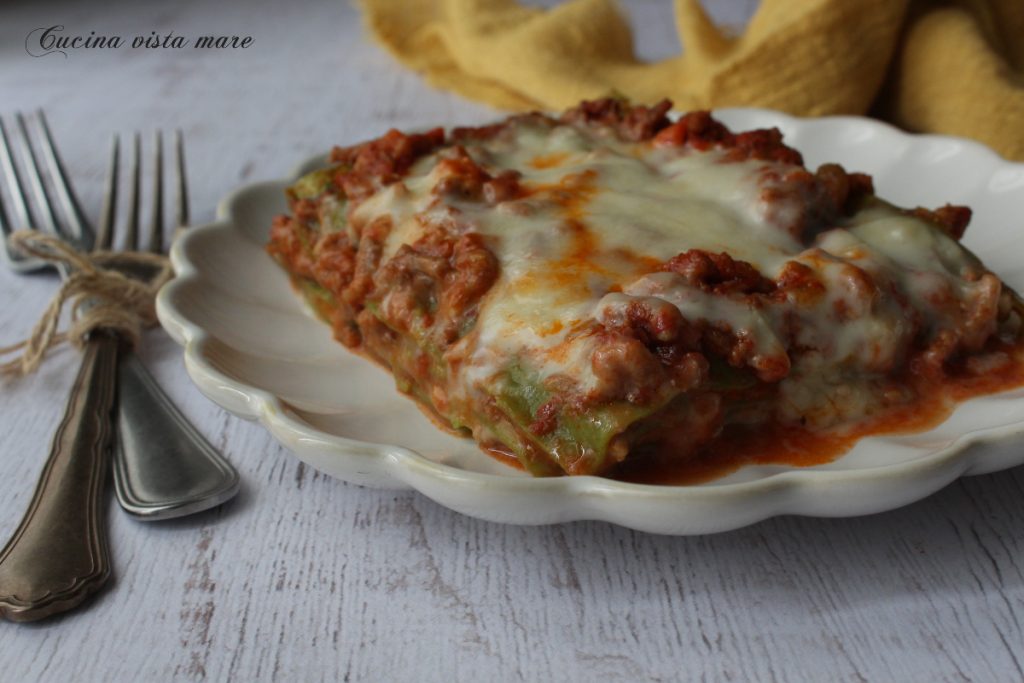Lasagna alla Bolognese is a typical Emilia-Romagna dish, a recipe traditionally served at Sunday lunches. In Bologna, in some trattorias, lasagna is part of the menu exclusively on Sundays. It is a festive and convivial dish, appetizing, rich, and succulent. The preparation of lasagna alla Bolognese is a bit laborious if you want to avoid shortcuts, but the result will reward the time and effort. After my recent trip to Bologna to taste this specialty directly there, I couldn’t help but share the original recipe for lasagna alla Bolognese.

- Difficulty: Medium
- Cost: Moderate
- Preparation time: 1 Hour 30 Minutes
- Portions: 2 people
- Cooking methods: Electric oven
- Cuisine: Regional Italian
- Seasonality: All seasons
Ingredients
To prepare the ragù, instead of homemade vegetable bouillon cube that I dissolve in half a glass of water, you can use vegetable broth. The soffritto should also include pancetta (for these quantities, you’ll need about 3.5 oz).
- 1.8 oz soffritto mix (celery, carrot, and onion)
- 12.3 oz ground selected beef
- 3.4 tbsp red wine
- 1/2 teaspoon homemade vegetable bouillon cube (or half a glass of vegetable broth)
- 21.2 oz tomato puree
- 1 tbsp extra virgin olive oil
- to taste salt
- 8.8 oz béchamel
- 8.8 oz green lasagna sheets
- 3.5 oz grated Parmesan cheese
Tools
- 1 baking dish 15 x 9 inches
Steps
I usually don’t add oil to the ragù because the meat’s fat is enough for me, making it more delicate and digestible, but being a traditional recipe, it should be prepared according to the original recipe.
If using: finely chop the pancetta. Finely chop carrots, celery, and onions. In a saucepan, pour the tablespoon of oil and the pancetta, let it brown, then add the soffritto mix. Stir and let it flavor for a few minutes. Add the selected beef, stir and let it brown well over medium heat. Deglaze with red wine and let it evaporate. Add the tomato puree and bring to a boil. At this point, add a ladle of vegetable broth or half a glass of hot water with dissolved vegetable bouillon cube. Adjust the salt.
Let the ragù cook for a couple of hours with the lid on but leaving a small gap and stirring occasionally.
To prepare the lasagna, you can choose to make the pasta at home: HERE you will find the recipe or you can buy the ready-made sheets, but for lasagna alla Bolognese, it must be green sheets, please!
As with the sheets, you can also decide to buy ready-made béchamel or make it at home: you can find the recipe HERE.
If I use fresh pasta, I usually put it directly in the dish without boiling it, but some prefer to do this step: boil the sheets one at a time in salted boiling water, let them cook for about 30 seconds, then drain with a slotted spoon and transfer to a work surface on a clean cloth (preferably not washed with detergent). Pat with another cloth to remove excess water and continue the same way with all sheets.
Pour a few spoonfuls of sauce and béchamel on the bottom of the baking dish and cover with the sheets, placing them side by side without overlapping. Add béchamel, ragù, Parmesan, and continue layering: I had six sheets as large as my baking dish and used them all, but five layers are sufficient. After placing the last sheet, cover all the pasta with ragù and sprinkle with grated Parmesan. If desired, you can add some knobs of butter (I prefer without and finish with a bit of béchamel). Bake in a preheated oven at 356°F (180°C) for 35/40 minutes.
Notes
There can be many variations to the ragù: as always happens with traditional recipes, every home has its personal recipe. I prepared it as I usually do, indicating in the recipe some possible additions and shortcuts.
What should not be changed is the sheet: in lasagna alla Bolognese, it is green sheets and the filling uses only ragù, béchamel, and Parmesan.

